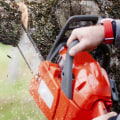For some reason, many people believe that pruning trees in autumn is the perfect time of year, especially when there are four seasons present. But this assumption could be damaging to your precious trees, even mature ones. The truth is that winter is the ideal time to prune and shape trees. When trees are dormant in cold weather, it's easier to visualize the structure of the branches.
It's also important to perform this task before the weather warms up, so as not to reduce growth. Late winter and early spring pruning helps trees sink all of their precious energy into producing healthy new growth once the climate warms up. As a rule, light summer pruning can be done on most deciduous trees and shrubs. A more intensive pruning should be carried out when the tree is inactive, preferably in late winter, before active growth begins.
Trees such as maples (Acer) bleed heavily sap and should be pruned in winter while trees are dormant. Shrubs that bloom in spring, such as lilac and forsythia, bloom during the growth of the previous season and must be pruned within two weeks after flowering. Pruning at any other time will reduce or eliminate flower display. At any time between late autumn and early spring, it is better to prune or prune trees. In general, after the leaves fall and before the flowers appear, it is the ideal window. For most tree species, pruning trees in spring can give good results.
Although sap is increasing on the tree during this period of time, early spring makes it possible to easily identify problem branches before the tree has completely defoliated. Usually, tree pruning or tree pruning in Texas is best when temperatures cool in the fall and before buds start to grow in the spring. Removal of dead, broken or damaged limbs can be done at any time. The worst time to prune a tree is in spring, right after it has sprouted. The tree will have already used its energy to start a new growth, and it will not be able to recover from pruning as well or as quickly.
At Texas Tree Surgeons, tree pruning is the most common service we provide and is essential to maintaining health and safety in our urban forest. Qualified tree care specialists are pruning trees every day throughout the year without many detrimental effects. In addition to exposing problem areas, tree pruning in spring makes it easy to see which branches are dead and subject to removal. However, if the move is not included in the cost or if you are trimming the trees yourself, look for the moving services offered by the city. Pruning trees at the right time in the fall or winter cannot compensate for the damage caused by excessive pruning, lion's tail or hedging. However, when there is a risk of certain diseases, such as oak wilting, painting the wounds of tree pruning is an important protective measure.
Cuts take longer to heal during this period of time because the tree goes into dormancy and when trees with fungal diseases release large amounts of spores after being cut, the risk of infection from released sports increases. Having an ISA-certified arborist examine your trees before pruning them is crucial to ensuring proper care. Knowing when to prune trees keeps them healthy in the long run and sets them up for a robust growing season. In addition, this time period can help identify trees that cannot be saved, in which case you can schedule tree removal and removal services. Although it is possible to prune trees in summer, it can be more difficult because once the leaves cover the trees completely, it can be difficult to identify problem branches.
Pruning these tree species in summer helps you avoid the sticky mess you might experience with these species at other times of the year.


